Merge Gmail Accounts
- Switching back and forth between email accounts is painful, and takes alot of time.
- Do you agree it would be better to manage all your email accounts under one single Gmail? If yes, that's what i’ll show you in this video.
- You will see how to merge Gmail accounts and manage all your incoming and outgoing emails under one single gmail account.
My Use Case
- So in my case I have two mailboxes, the first one is my work mailbox which is work@goldyarora.com and the second one is my personal mailbox which is personal@goldyarora.com.
- It doesn't matter whether your email is @gmail.com or @yahoo.com, the concept is the same. We want to be able to manage multiple mailboxes without having to switch from one mailbox to another.
- So what I want is that when any email is sent to my personal email address (personal@goldyarora.com) that should also come to my work email (work@goldyarora.com) and vice versa.

POP Fetcher Vs Email Forwarding
- In Gmail we have two options; POP Fetcher and Email Forwarding.
- POP Fetcher is a protocol which fetches emails from one mailbox to another. Go for this option if you need to fetch your old emails as well the new ones.
- Under Email Forwarding you define a rule that sends a copy of every email from one mailbox to another. Go for this if you're only concerned about emails from now onward.

1. Enable POP
- Before we configure POP from the primary email, we have to make sure that POP is enabled in our other mailbox.
- To enable POP, go to "Settings", then switch to "Forwarding and POP/IMAP" then click on "Enable POP for all mail".
- You can also define what should happen when emails are fetched from this mailbox. I recommend keeping a copy.
- In case you don't see "Forwarding and POP/IMAP" tab, that means it's disabled. Request your Google Apps administrator to enable it for you.
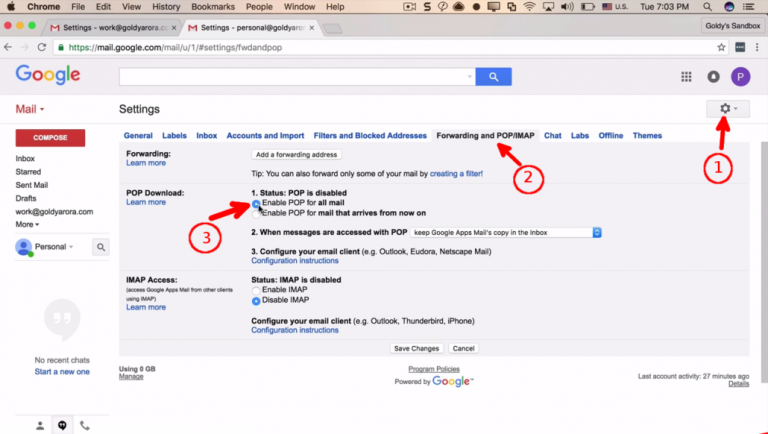
2. Add a POP3 account
- Now that we're done with configuring POP in our other email, we can now add a POP account to our primary mailbox.
- So, to add a POP account, click on icon and choose "Settings". Switch to "Accounts and Import" tab. Then click on "Add POP3 account you own".
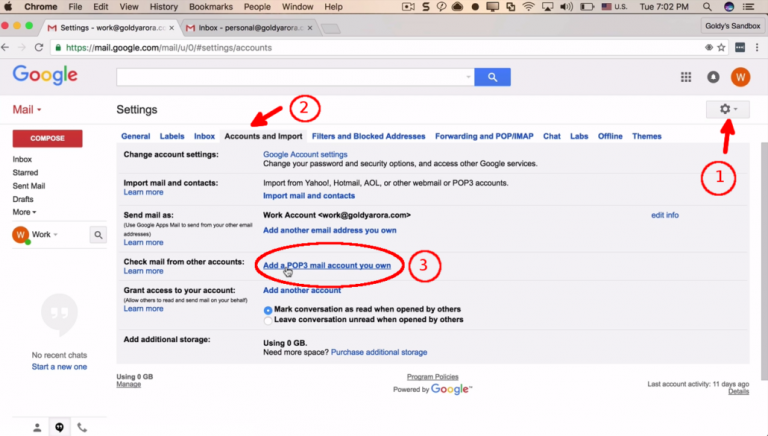
3. Configure POP3 Account
- To add a mail account, complete the form by filling in your other email address (personal@goldyarora.com in my case) and password.
- Each email server has it's own POP server address. If you're using Google Apps you should use "pop.gmail.com".
- For port number you can use 955.
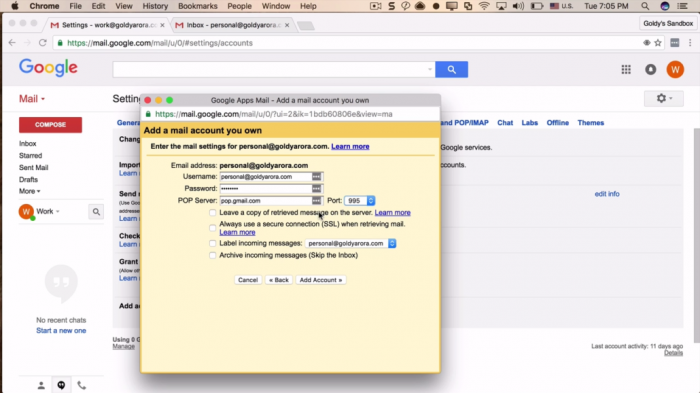
Configure POP3 Account (part 2)
- The first option "Leave a copy of retrieved message on the server". Leave this unchecked otherwise you'll get an error.
- The second option is "Always use a secure socket layer" which is recommended. Check this to make it secure.
- I guess the next option "Label incoming messages" would be good so you can easily identify these messages.
- Last option is whether you want these emails to skip your inbox and directly be archived under their label. I suggest you keep this unchecked.

4. Third-party block error
- Now you may get an error "Server denied POP3 access for given username and password".
- In my case when I go to my "personal@goldyarora.com", Gmail says it has blocked an attempt from a third-party app.
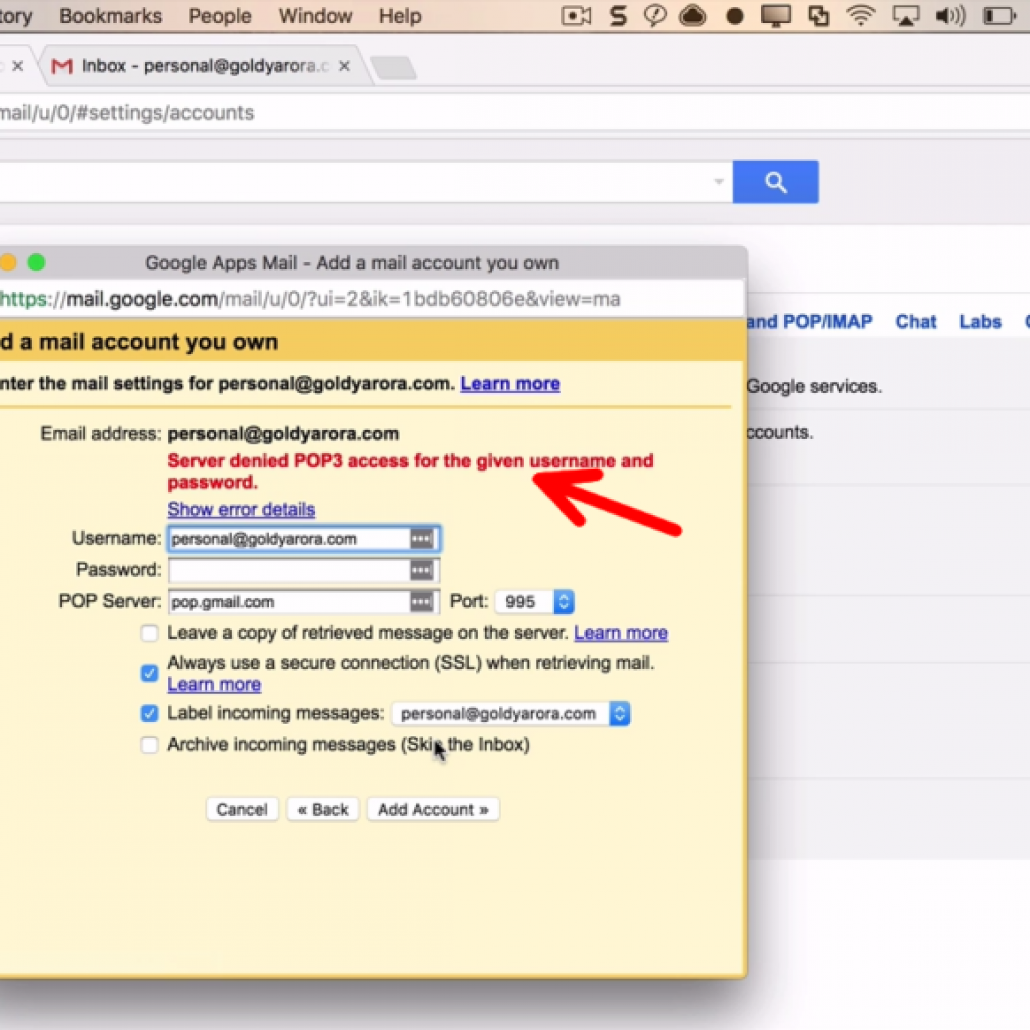
5. Fixing Third-party Error
- Now Gmail is acting weird here because it's considering it's own app as less secure. I'm not sure why it acts like this anyway.
- What we need to do here is; go to the secondary email (personal@goldyarora.com in my case)
- Click on your email profile picture, then click on "My Account".
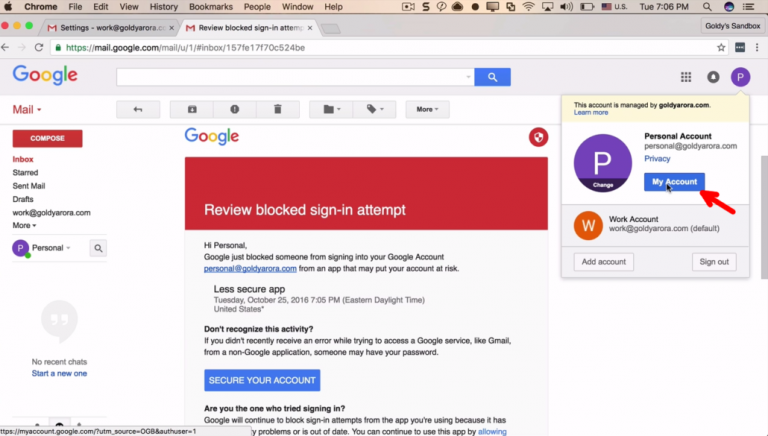
Fixing Third-party error (part 2)
- Under "My Account" click on "Connected apps & sites" option which is in the "Sign-in & Security" section.

Fixing Third-party error (part 3)
- So when you scroll down the page, you will notice that "Allow less secure apps" is off.
- Toggle the button next to it and accept "that's OK, I understand my risk so I am okay with this".
- "Allow less secure apps" will now turn ON.

6. Try adding POP3 account again
- So after turning on "Allow less secure apps" on, go back and fill in your email address and password again.
- This time it went on well.

7. Allow sending email from your other email
- So Gmail says you are all set and should be fetching all the emails, but do you also want to send from this email address right from your primary email?
- Because I would love to send emails using "personal" email when I'm on "work" email, I will check this and I suggest you do the same
- Then click "Next step".
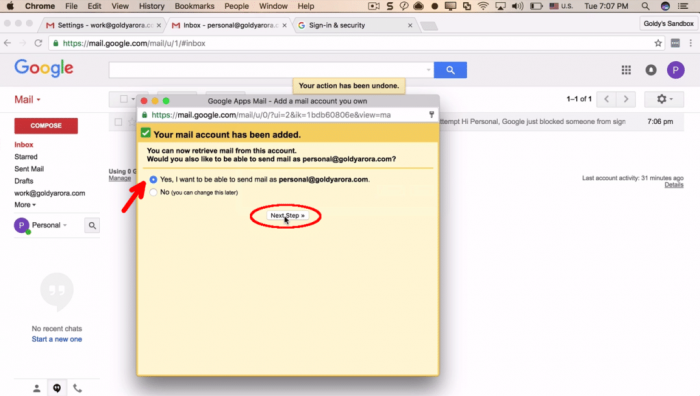
8. Name your account & uncheck "treat as alias".
- So now you can give your account a name. Whatever name that works for you, I will name mine "Personal account".
- Uncheck "Treat as an alias". And if you want to learn why I recommend unchecking this, click on the "learn more" link.
- Click "Next step".

8. Email Verification
- Now Gmail doesn't allow you to send from any email address unless you verify that you own that email address. This is to prevent you from abusing their system.
- So for that reason, click "Send verification" to let gmail send a verification to your other email address.
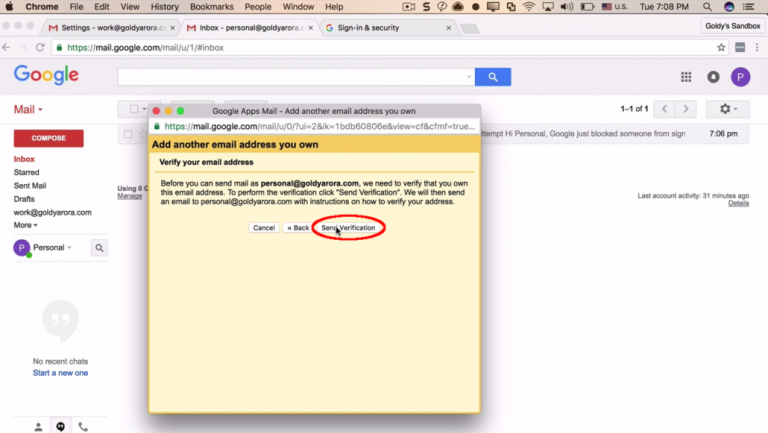
Email Verification (part 2)
- You will receive an email containing the code in your other email address ("personal" in my case).
- Copy and paste the code. Click "Verify".
- All is set!
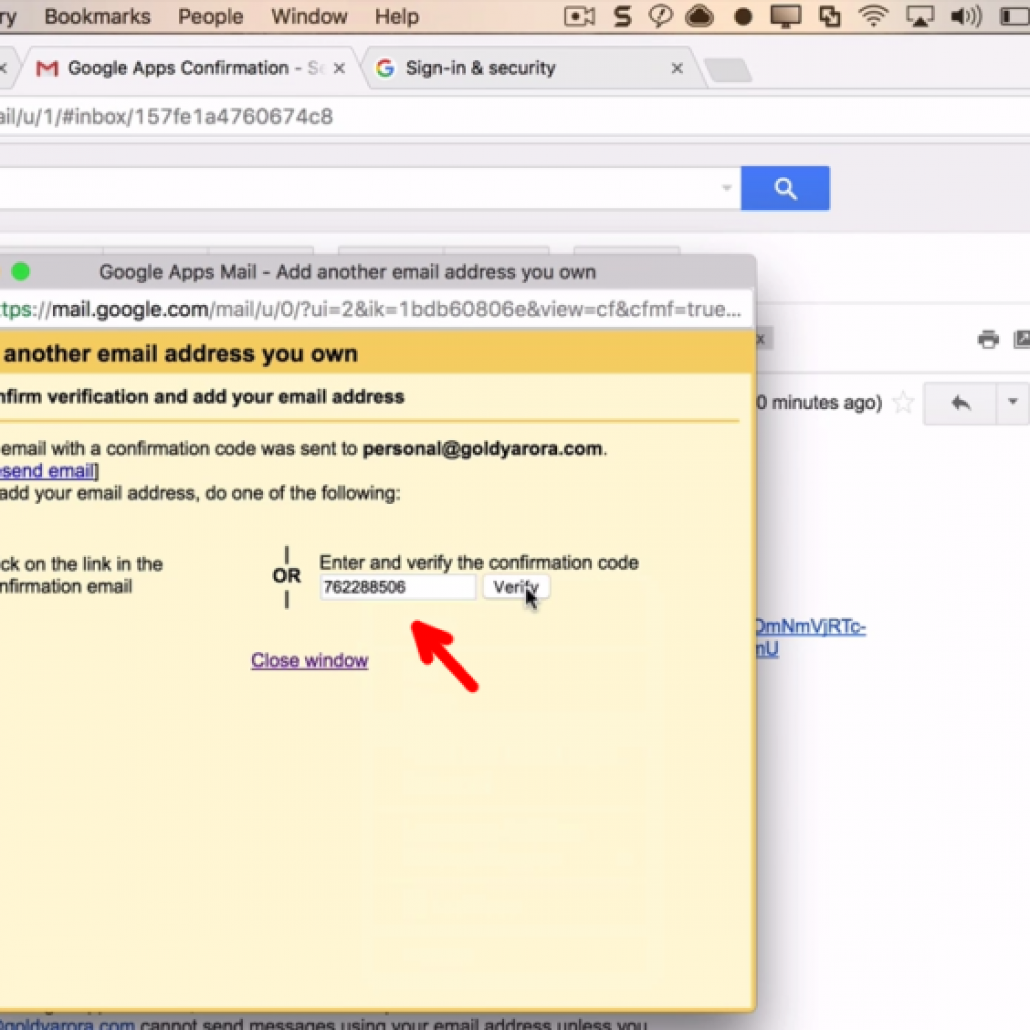
Checking emails
- Now if you go to your primary email (work email in my case), under "Settings" then "Accounts and import". Under "Check mail from other accounts", you see "Checking mail" under the email address you just configured.
- It may take some time because it's pulling emails from the other email, it's not like the other mailbox is pushing. So it takes time.
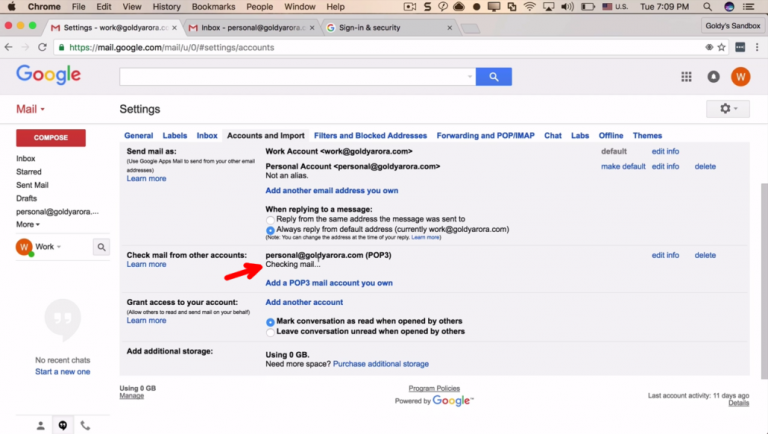
9. Composing emails
- When it comes to composing an email, you notice that you now have a drop down.
- Here you can select whether you want to send a specific email from one of the emails (work@goldyarora.com or personal@goldyarora.com).

10. Setting a default email address
- If you want to define a rule such as making any of the emails the default for sending or replying, then go to "Settings", then "Accounts and imports" and here you can define the default behavior.
- You can either choose to always reply from default email address or reply from the same address the message was sent to.
- In my case, I will go with "Reply from the same address the email was sent to".
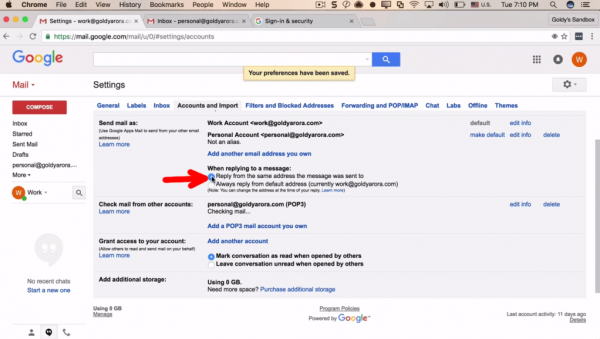
An example of fetched email
- So after some time, the email which I had in my personal mailbox is now in my work email. It has been fetched from my personal mailbox.
- As you can see, it has been given my personal label. And when I click on "Reply", by default a reply is being sent using the same email it was sent to, however I have an option to change and send from the other.
- I hope it was helpful. If you have any questions don't hesitate to put them in the comment section below and I would love to help. Thank you so much!
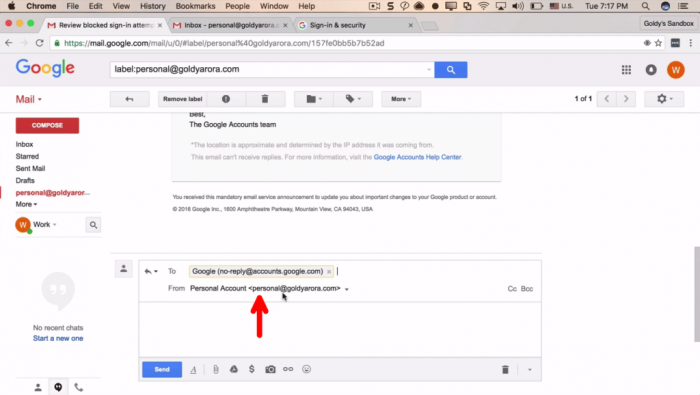
If you h
Related Posts
....
....

